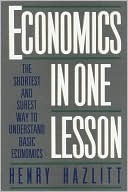More on this book
Community
Kindle Notes & Highlights
Read between
September 10 - November 11, 2018
The volume is therefore primarily
one of exposition.
selfish interests.
This is the persistent tendency of men to see only the immediate effects of
In this lies the whole difference between good economics and bad.
The bad economist sees only what immediately strikes
The art of economics consists in looking not merely at the immediate but at the
longer effects of any act or policy; it consists in tracing the consequences of that policy not merely for one group but for all groups.
Yet the broken-window fallacy, under a hundred disguises, is the most persistent in the history of economics.
But such complications should not divert us from recognizing the basic truth that the wanton destruction of anything of real value is always a net loss, a misfortune, or a disaster, and whatever the offsetting considerations in a particular instance, can never be, on net balance, a boon or a blessing.
Here we shall have to say simply that all government expenditures must eventually be paid out of the
proceeds of taxation; that inflation itself is merely a form, and a particularly vicious form, of taxation.
ultimately every dollar of government
spending must be raised through a dollar of taxation.
am here concerned with public works considered as a means of “providing employment”
Therefore, for every public job created by the bridge project a private job has been destroyed somewhere else.
What has happened is merely that one thing has been created instead of others.
As a character in Bernard Shaw’s Saint Joan replies when told of the theory of Pythagoras that the earth is round
and revolves around the sun: “What an utter fool! Couldn’t he use his eyes?”
GOVERNMENT “ENCOURAGEMENT” TO business is sometimes as much to be feared as government hostility. This supposed encouragement
This is only another way of saying that the government lenders will take risks with other people’s money (the taxpayers’) that private lenders will not take with their own money.
But the government goes into the lending business in a charitable frame of mind
because the available real capital (consisting of actual farms, tractors, etc.) has been placed in the hands of the less efficient borrowers rather than in the hands of the more efficient and trustworthy.
This means that bureaucrats should be permitted to take risks with the taxpayers’ money that no one is willing to take with his own.
In the case of government-lending the money is
that of other people, and it has been taken from them, regardless of their personal wish, in taxes.
Government loans will waste far more capital and resources than private loans. Government loans, in short, as compared with private loans, will reduce production, not increase it.
sees the immediate benefit to one group; it overlooks the losses to other groups, and the net loss to the community as a whole.
When the government makes loans or subsidies to business, what it does is to tax successful private business
in order to support unsuccessful private business.
Santayana’s aphorism that those who cannot remember the past are condemned to repeat it.
The central lesson is that we should try to see all the main consequences of any economic policy or development—the immediate effects on special groups, and the long-run effects on all groups.
The spread-the-work schemes, in brief, rest on the same sort of illusion that we have been considering.
The people who support such schemes think only of the employment they might provide for particular persons or groups; they do not stop to consider what their whole effect would be on everybody.
was that of considering merely the immediate effects of a tariff on special groups, and neglecting to consider its long-run effects on the whole community.
it helps the protected producers at the expense of all other American producers, and particularly of those who have a comparatively large potential export market.
Thus all the chief tariff fallacies stem from the central fallacy with which this book is concerned. They are the result of looking only at the immediate effects of a single tariff rate on one group of producers, and forgetting the long-run effects both
on consumers as a whole and on all other producers.
It is merely directed against the fallacy that a tariff on net balance “provides employment,” “raises wages,” or “protects the American standard of living.”
Paradoxical as it may seem to some, it is just as necessary to the health of a dynamic economy that dying industries be allowed to die as that growing industries be allowed to grow.
THE WHOLE ARGUMENT of this book may be summed up in the statement that in studying the effects of any given economic proposal
we must trace not merely the immediate results but the results in the long run, not merely the primary consequences but the secondary consequences, and not merely the effects on some special group but the effects on everyone.
It follows that it is just as essential for the health of a
dynamic economy that dying industries should be allowed to die as that growing industries should be allowed to grow.


